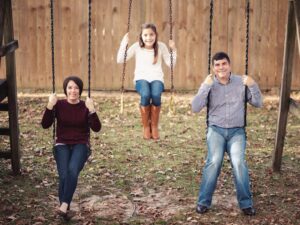“I have zero reservations saying that I don’t think I would have survived to my 31st birthday. My heart was so weak. The fact that I could get up and function every day was a miracle,” says Mary Leah Coco.
On Veteran’s Day in 2010, Mary Leah walked into a cardiologist’s office for a well visit, and she received news that changed everything. At the age of 30, Mary Leah was diagnosed with dilated cardiomyopathy, an enlarged heart. The appointment went as expected in the beginning. “I had a perfect EKG, perfect weight, perfect blood pressure, but because of my mom’s heart, they decided to do an echocardiogram,” which showed that her heart was functioning with an ejection fraction of just 10 percent. A healthy heart has an ejection fraction of 50-75 percent. Mary Leah was in massive heart failure, and she didn’t have a clue just an hour before.
Two years earlier, her mother was diagnosed with a hole in her heart. At the time, Mary Leah was eight months pregnant with her daughter, Annie. “I think of all the times mothers save their children not knowing that they’ve done it. If my mom hadn’t gone to the doctor, then I wouldn’t be here.” And it was her own motherly love for her daughter, Annie, that drove her to make her own appointment. She explains, “I knew that heart disease has a big family history, especially congenital heart defects, so I went to get the green light that I was okay and so was Annie.”
Mary Leah didn’t think she had the common symptoms of heart failure: shortness of breath or trouble breathing, fatigue, swelling in the ankles, feet, legs, abdomen and veins in the neck. “Yeah, I was tired, Annie was two. I was going to work full time, in school full time, and I was writing my dissertation. I had some edema in my extremities, but who doesn’t after being on their feet all day? At least that’s what I thought.”
Mary Leah emphasizes that women don’t need to wait for the huge signs or permission from others to schedule a checkup. More women die from heart disease than every form of cancer combined. One woman every 80 seconds, which is over a half million. Mary Leah shares, “I was healthy. I didn’t smoke, I didn’t drink. I exercised. There’s a huge stigma with heart disease which is why we have such difficulty educating people because they think you’ve done something wrong to have heart disease. Lifestyle is only about a third of a contributing factor.”
After the diagnosis, the Cocos’ lives changed dramatically. Mary Leah went from taking no medicines to multiple prescriptions. She started going to the Cleveland Clinic in Ohio, where she is still an active patient. She had to make changes in the way she ate and exercised. The greatest change occurred in 2011, though, when she had surgery to place an Implantable Cardioverter Defibrillator (ICD).
The surgery was successful, and Mary Leah has lived with the ICD for almost seven years now. She ebbs between about 35-40 percent ejection fraction, which is still clinically heart failure. She takes 13 medicines a day and has to make daily choices to take care of herself. She explains, “The hardest thing was I had to reshape the vision I had for what my life would look like. That was a lesson for me that dreams and goals can change, and we have to be willing to be flexible.”
Mary Leah has learned many life lessons through her heart journey, and she delights in sharing her wisdom with others. “Because the American Heart Association has allowed me to share my story, I can make a message out of the mess,” she says. “Because I don’t look like I have heart failure, I can hopefully help people not feel ashamed if they’re diagnosed with heart disease. You could have done everything right, and still be diagnosed.”
She wants people who are given a frightening diagnosis to know that it “does not mean life is over. Talking about it is very important. Accept the fact that you are not a failure. You didn’t do anything to deserve it. Hold on to hope and don’t feel abandoned. Shifting how you choose to perceive who you are, where you are, and how you are going to tackle the obstacle in front of you is very powerful,” Mary Leah encourages. ■





